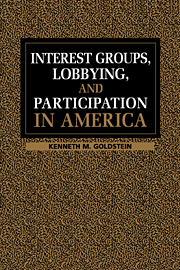Book contents
- Frontmatter
- Contents
- List of Figures and Tables
- Acknowledgments
- 1 Introduction
- 2 Patterns and Puzzles in Participation and Lobbying
- 3 The Political Logic of Political Decisions
- 4 Explaining Lobbying Decisions
- 5 Lobbying Decisions and the Health Care Reform Battle
- 6 Patterns of Recruitment and Participation in the Mass Public
- 7 Conclusion
- Appendix A Sources and Coding for Survey Data
- Appendix B Interest Group Sampling Frame
- Appendix C Chronology of Health Care Reform Legislation
- Bibliography
- Index
Appendix C - Chronology of Health Care Reform Legislation
Published online by Cambridge University Press: 23 September 2009
- Frontmatter
- Contents
- List of Figures and Tables
- Acknowledgments
- 1 Introduction
- 2 Patterns and Puzzles in Participation and Lobbying
- 3 The Political Logic of Political Decisions
- 4 Explaining Lobbying Decisions
- 5 Lobbying Decisions and the Health Care Reform Battle
- 6 Patterns of Recruitment and Participation in the Mass Public
- 7 Conclusion
- Appendix A Sources and Coding for Survey Data
- Appendix B Interest Group Sampling Frame
- Appendix C Chronology of Health Care Reform Legislation
- Bibliography
- Index
Summary
Before examining the strategic and tactical choices of grass roots lobbyists, it is important to understand the basic policy issues, political environment, and chronology of events in the battle over the Clinton plan and health care reform. (For more comprehensive accounts, see Johnson and Broder 1996; Congressional Quarterly Almanac 1994; Skocpol 1996; and Clymer et al. 1994.)
The 1,364-page Clinton plan was ambitious. It promised guaranteed coverage for all Americans by 1998. The funding mechanism was an employer mandate that would have required employers to pay 80 percent of their workers' health insurance costs. The plan included spending caps on health insurance premiums, a requirement that drug companies pay rebates to the Medicare program, and a national health board responsible for reviewing prices for new drugs and establishing global budgets to limit the nation's total spending on health care. In addition, the Clinton plan required Americans to purchase their health insurance through large purchasing groups dubbed alliances. The plan also included a seventy-five-centsa-pack increase in the cigarette tax and a levy on large employers that did not join the health alliances (Pear 1996).
As the Clinton plan was referred to committee there were three other major competing plans. To the left of the Clinton plan was the single-payer proposal introduced by Representative Jim McDermott of Washington State. This plan was patterned after the Canadian system and would have replaced private insurance companies with the federal government.
- Type
- Chapter
- Information
- Interest Groups, Lobbying, and Participation in America , pp. 144 - 146Publisher: Cambridge University PressPrint publication year: 1999



